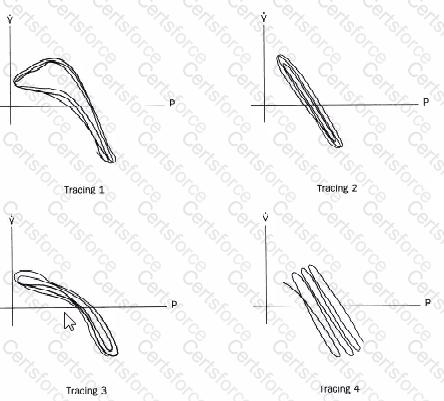Which of the following is the most reliable indicator that a patient has achieved his maximum exercise capacity during a progressive exercise (stress) test?
At maximum exercise, a 24-year-old patient's heart rate is 150/min with a VO2of 750 mUmin. The calculated 02 pulse is most consistent with which of the following?
A 54-year-old male with a normal ECG at rest develops dyspnea during an exercise (stress) test, and the following ECG pattern is noted at 25 watts:

25 mm/sec A pulmonary function technologist should
A treadmill belt stops for a fraction of a second each time the patient takes a step. A pulmonary function technologist should
During calibration of a spirometer, injection of air with a 3-liter syringe results in the following:
Using another 3-liter syringe, air is again injected with the following results:
A pulmonary function technologist should conclude that the

Which of the above patterns illustrates the effect of increasing temperature in the plethysmograph during airways resistance measurement?
The following results are obtained from an adult patient:
Which of the following is the best interpretation of these values?
While assessing a patient's expired gases at rest prior to exercise, a pulmonary function technologist calculates the RER as 0.6. Which of the following is the most likely explanation?
Which of the following problems may be identified by using an isothermal lung analog to perform quality control on a body plethysmograph?
1. Improperly calibrated mouth pressure transducer
2. Obstructed or perforated pneumotachometer
3. Increase in mechanical resistance
4. Malfunctioning box pressure transducer
While reviewing exercise data, a pulmonary function technologist notes that the patient's anaerobic threshold occurred at 35% of the patient's VO2MAX. This indicates the patient has